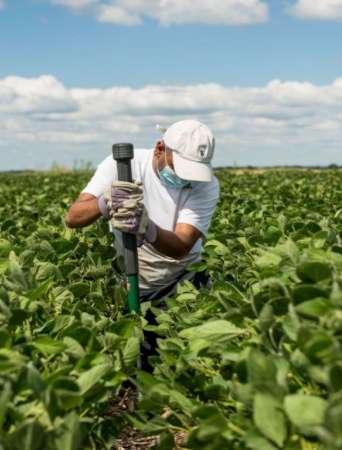By Christie Delfanian
Farmers who make soil health a priority are more likely to rotate three or more crops and to graze livestock on cropland, according to a survey of producers in South Dakota, North Dakota and Nebraska.
The survey examined why some agricultural producers prioritize soil health and how to encourage more producers to adopt these conservation practices, according to assistant professor Tong Wang of South Dakota State University’s Ness School of Management and Economics. This is the first study addressing what motivates Northern Great Plains producers to adopt these practices.
The research is part of a four-year, nearly $4 million U.S. Department of Agriculture project that seeks to evaluate the impact of an integrated crop and livestock management system that involves using cover crops, such as oats, for grazing as part of the crop rotation plan. The National Institute of Food and Agriculture project, which involves 26 scientists from five universities, is led by associate professor Sandeep Kumar of SDSU’s Department of Agronomy, Horticulture and Plant Science.
Producers play a key role in preventing and reversing soil degradation, said Wang, who is the lead author on an article in the May 2019 issue of the Journal of Agricultural and Resource Economics detailing the study results.
“If we can show producers that soil health is important to long-term profitability, they will be more likely to adopt these practices,” she said. A 2003 to 2011 Iowa study, for instance, showed rotating three to four crops increased corn and soybean yields by 4 to 9% and reduced fertilizer and herbicide application rates by at least 80% when compared to a conventional soybean-corn rotation plan.

Current usage of conservation practices
Of the 672 farmers who responded to the survey, nearly 38% were using diversified crop rotation plans, while 71% were grazing livestock on croplands. However, only 28% of the respondents used both methods to improve soil health.
South Dakota producers were most likely to adopt both practices, with 33% using both diversified crop rotations and integrated crop and livestock systems, Wang said. More than 70% of the South Dakota respondents use an integrated crop-livestock management system, while nearly 40% integrate a third or fourth crop into their soybean-corn rotation.
More than 75% of the respondents work full time on the farm and only 12% planned moving within the next five years, even though the average age of the respondents was 63 years old. However, the average age of the respondents is in line with that of producers in the three-state area, Wang explained. Those who responded to the survey tended to have more cropland than the average producer in their respective states.
How to increase adoption rates
“Those who pay more attention to soil health and stewardship do not worry too much about an immediate profit increase and are more likely to adopt these conservation measures,” Wang said.
Diversified crop rotation may require the purchase of new equipment, she explained. Because larger operations can spread the cost over more acres, the likelihood that a producer will diversify the rotation increases by 3.8% for each additional 1,000 acres of land farmed.
In terms of incentives to increase adoption rates, the survey showed that a $45 per acre incentive would be enough for producers to diversify their crop rotation plans, while only $30 per acre would encourage farmers to adopt an integrated crop and livestock management system.
Despite concerns about soil compaction decreasing water infiltration, producers see grazing croplands as less risky than adding a third or fourth crop to their rotation plans, Wang said.
Surprisingly, producers who had gone to college or earned a college degree were 11.8% less likely to graze livestock on cropland. These farmers tend to specialize in either crop or livestock production, she noted.
Producers who prioritize profits over stewardship may be enticed to try these conservation measures through an incentive program. However, Wang said, “those who require lower financial incentive are more likely to adopt conservation measures than those who require a higher economic incentive.”
Research, such as the USDA project, can show producers the benefits of using these soil-improving management strategies, but government incentive programs can provide short-term compensation—until the producers begin to collect those long-term rewards.